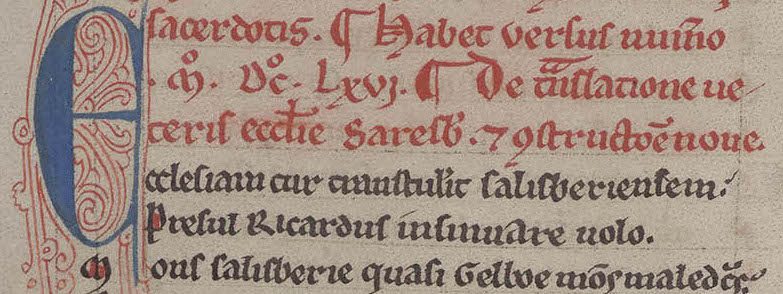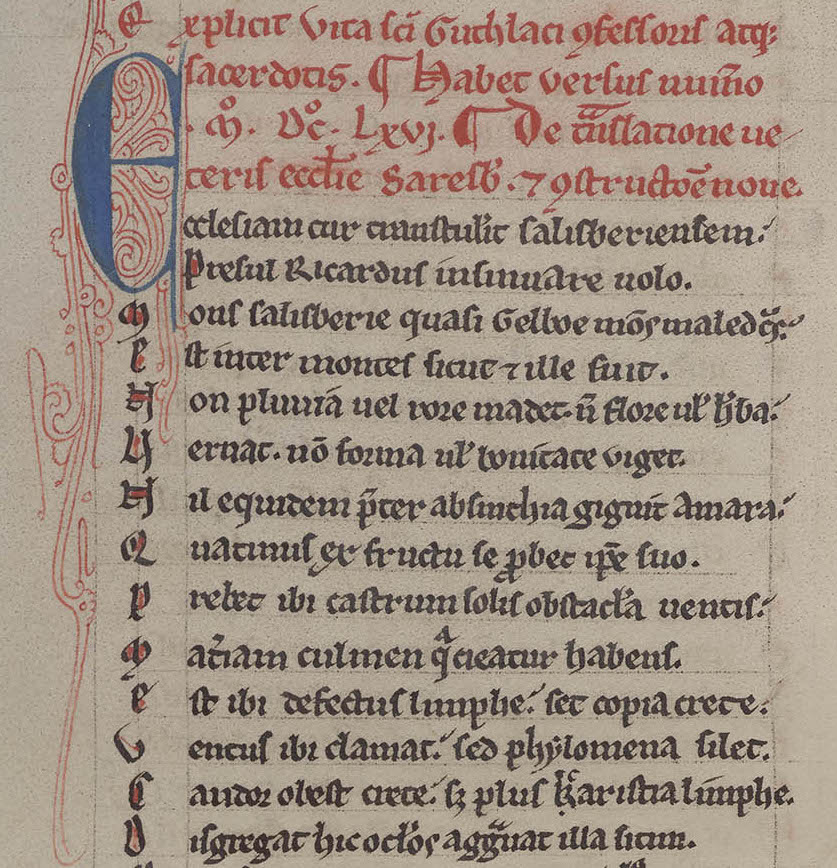
Salisbury Cathedral’s 800th anniversary and a medieval poem in Cambridge University Library
Guest post by Dr Francis Young.
On 28 April 1220 Bishop Richard Poore laid the foundation stone of Salisbury Cathedral, which is unique among English cathedrals for having moved entirely from its original location at Old Sarum to a new greenfield site at the confluence of three rivers. While events like the foundation of a new cathedral were frequently recorded in medieval chronicles, literary works commemorating such events are much rarer, yet one such document survives in Cambridge University Library. MS Dd.11.78 is a collection of Latin poems written by Henry d’Avranches (d. 1260), an itinerant cleric who seems to have specialised in topographical elegiac poems – some of them commissioned, perhaps, by the patrons of the places he wrote about. Among these poems (fols 92v–96r) is Henry’s prosaically titled De translatione veteris ecclesie Saresberiensis et constructione nove (‘On the translation of the old church of Salisbury and the construction of the new’), which was written between 1220 and 1225.

While Henry d’Avranches’s poem received a prose translation in 1960, last year I was asked by Salisbury Cathedral to make a new verse translation which could be set to music as an anthem, to be composed by Morgan Pochin. ‘The Salisbury Anthem’ was duly completed for the Cathedral’s 800th anniversary in April 2020, only for the Coronavirus pandemic to put paid to any opportunity of performing it. Instead, on 3 May 2020 BBC Radio 4 broadcast a service of Sunday worship led by the bishop, dean and chapter of Salisbury in which actor Simon Russell Beale read part of my translation of Henry d’Avranches’s poem.
Henry’s poem describes the challenges faced by the canons of the cathedral at Old Sarum, where the cathedral was located inside a royal fortress. The cathedral’s location within a fortress threatened the church’s independence from royal control, and the canons were often compelled to feed the soldiers garrisoned there. The canons faced other hardships, too; Old Sarum is a chalk hill where the white ground, according to Henry, blinded the canons with its glare. Furthermore, the noise of the wind on Old Sarum hill made it impossible to worship fittingly, lack of water meant that the canons were always thirsty, and they were exhausted by the steep ascent to the cathedral. Henry praises Bishop Richard Poore for taking the decision to move the cathedral to the valley below Old Sarum, and compares the site of the new cathedral to a second Eden. While Henry d’Avranches was no doubt indulging in poetic hyperbole, the meadows around Salisbury Cathedral have inspired many artists (most famously John Constable) and the cathedral’s setting is famously beautiful.
The aspect of Henry’s poem most alien to the modern reader is his lengthy medical digression on the eyes and ears in order to explain and justify the need to remove the cathedral from Old Sarum – a display of learning and erudition of a kind that many thirteenth-century readers may have appreciated, but to the modern reader seems a bizarre departure from the narrative. Nevertheless, Henry’s poem is a politically controversial critique of the government of the royal justiciar Hubert de Burgh, earl of Kent, who was effectively governing England in 1220 during the minority of Henry III. Weak royal government under a boy king had led to abuses within the royal fortress of Old Sarum, making it necessary for the church to break free. At the same time the poet praised Henry III – who was thirteen in 1220 – for supporting the building of the new cathedral. In the end, Henry d’Avranches presents an idyllic clerical ideal of the new cathedral as a return to nature and to the innocence of paradise. It seems unlikely that Henry ever saw the cathedral largely completed in 1258, but he envied those who would:
Happy the one who lives so long to see
The church complete, after such labour done;
Its artful care shines for posterity,
Since bishop, king and mason worked as one.
I look forward to the day when Salisbury Cathedral’s 800th anniversary can be celebrated in the cathedral itself, and Henry d’Avranches’s words can be sung by the cathedral choir in The Salisbury Anthem.
*I am indebted to Salisbury Cathedral’s Archivist, Emily Naish, for her insights on the poem.
